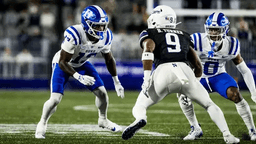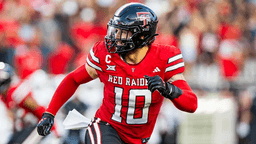NCAA Baseball Tournament Top 10 Prospects from the Carolinas
Top 10 Baseball Prospects from Carolinas
By: Draft Carolina · 1y

The NCAA Men’s Baseball Tournament begins this weekend at 16 college sites. The players competing in this first round will be focused on advancing to the Super Regionals, but for dozens, they will also be trying to catch the attention of Major League Baseball Scouts. With the MLB Draft looming in mid-July, this will be collegiate players last opportunity to impress franchises and attempt to move up organizational draft boards.
Like most drafts, all 30 teams will select a healthy dose of prospects who spent this season honing their skills with teams based in the Carolinas. Multiple prospects will be on the field at the same time due to teams from the Carolinas being scheduled to meet in regional play. There are prospects from the Carolinas in, or close to, the Top 100 available according to MLB Pipeline.
No. 4 - Nick Kurtz, 1B, Wake Forest
Kurtz and his 65 grade power would be the top power projected bat in this year’s draft if Charlie Condon (Georgia), Travis Bazzana (Oregon State), and Jac Caglianone (Florida) weren’t destroying school and NCAA home run records. His career with Wake includes 61 home runs, 187 RBI, and a 1.244 OPS. Kurtz displays excellent bat speed that he uses to propel the baseball to all fields. He is not a two outcome bat either, having posted a career .512 OBP. Unlike other sluggers who end up at first base because they are inadequate at fielding, Kurtz is athletic and fields his position well. He should remain a quality 1B in the pros.
No. 5 - Chase Burns, RHP, Wake Forest
Burns and his 100 MPH fastball will battle Arkansas LHP Hagen Smith for the honor of being the first pitcher selected in the draft. Burns does not just rear back and come out of his shoes. He does have an upper-80s change up that nicely compliments the heater. Like Paul Skenes last year, Burns hasn’t needed off-speed pitches to get batters out. His time in the minor leagues next year will be spent honing his secondary offerings. Between Tennessee and Wake Forest, Burns has maintained a 14.6 K/9 ratio. He can light up the radar gun, but it is a controlled fury. He has only walked 2.7 batters per nine innings and maintained a respectable 1.031 WHIP, including 0.874 this season.
No. 11 - Trey Yesavage, RHP, East Carolina
Yesavage began the NCAA season projected to be selected in the bottom third of round one. While he does not posses the power of Burns or Smith, he can approach triple digits on his fastball that normally sits in the mid-90s. He also makes greater use of his off-speed pitches, especially his late breaking cutter. Yesavage is not a high strikeout pitcher, relying more on his variety of offerings to induce weak swings. His delivery requires a good deal of effort from his 6’4”, 225 pound frame. That delivery and a collapsed lung that required two nights in the hospital might be a reason to take him off of the board for a handful of teams.
No. 13 - Seaver King, 3B/OF, Wake Forest
King is a versatile player who can be considered a late bloomer. He played his first two years at Division II Wingate before matriculating to Winston-Salem. He controls the strike zone well with a .365 BA and a 55/76 BB:K ratio. He is strong enough to spray the ball to all fields and occasionally over the fence. His SLG is .643. His above average speed allowed him to steal 31 bases in his career. That speed is a fundamental part of his exceptional defense. He has logged time at CF, 3B, 2B, and SS. He does not have enough power to remain at 3B, but he can succeed at the other three positions in professional ranks.
No. 20 - Vance Honeycutt, OF, North Carolina
Should Honeycutt cut down on his swings and misses, he could develop into a five tool prospect. Ideally built at 6’3” and 205 pounds, the Tar Heel possesses all the other elite tools. He defends exceptionally with above average speed and instincts. Honeycutt drives the ball when he barrels up the baseball. He is a base stealing threat whenever he is on base due to his speed. His athletic ability and strong arm gives him the defensive chops to play all three outfield positions. If he does not fully develop his hitting game, his Gold Glove caliber defense can carry him to the majors.
No. 34 - Jonathan Santucci, LHP, Duke
Smith will be the first collegiate LHP off the board. Santucci is in line to be the second. He is not the prototypical crafty lefty. His fastball has been recorded as high as 96 MPH and if batters think they can time his fastball, he induces awkward swings and misses with his low-80s slider or mid-80s change up. His control was always a little inconsistent and that flared up again earlier this year. If he falls to the back part of round one, that will be a contributing factor. Like Yesavage, there are medical risks with Santucci. He had surgery to remove bone chips from his elbow earlier in his Blue Devil career and he missed the ACC Tournament this season with a rib injury. He needs a solid and healthy NCAA Tournament to put the luster back on his status.
No. 42 - Jacob Cozart, C, NC State
Cozart is another prospect in competition to be the first at his position drafted. California’s Caleb Lomavita is currently ranked higher than the Wolfpack backstop, but a deep run to Omaha could close the gap. The hulking 6’3”, 222 pound catcher is strong. That shows up in his bat and his arm. His left handed swing produces an intriguing loft resulting in gap power. He frames pitches well and has enough game experience that he can be trusted when he calls for a pitch in any situation. He is a substandard runner who will clog up the bases and require multiple hits to score him from first.
No. 62 - Josh Hartle, LHP, Wake Forest
The “other” Demon Deacon starter. He does not put up the gawdy strikeout numbers that his teammate Burns does, few do, but he can also dial it up and blow it past hitters when needed. The former No. 1 rated prep LHP, Hartle has given Wake a 10.0/2.7 strikeouts to walks per nine innings ratio. This season, his strikeouts per nine are down and his walks per nine are up slightly. Those statistics have damped his prospect profile, but the tools are still there with a four pitch arsenal highlighted by a 90 MPH fastball that hits 94 with a smooth, repeatable delivery. The Deacons will rely on him on days that Burns is not available. If he can dominate in those games, he can re-establish himself as a rotational piece in the pros.
No. 68 - Tristan Smith, LHP, Clemson
Over the course of the last few drafts, general managers have begun selecting college bullpen arms that are projectable and could move quickly through the minor league system. Often, they are pitchers with starter potential but just have not developed consistency. Their college mangers use them in set up and closing situations. Clemson’s Smith could become the next pitcher targeted for this fast track. His underlying numbers do not justify his ranking. He has only started 16 of 34 games in which he has appeared. He has recorded only four saved games, all in his freshman season. His career K/9 of 11.9 is solid, but his WHIP of 1.569 and BB/9 of 6.7 are underwhelming. However, when a LHP can reach 96 MPH with elite spin rates and it can be harnessed in short bursts, scouts will take notice. That is Smith’s hope heading into the draft. Smith looks to be a boom or bust prospect.
No. 104 - Cole Messina, C, South Carolina
Few collegiate players finished as strongly down the stretch than did Messina. The Gamecocks’ catcher finished his last month of play batting .330 and slashing .465/.707/1.172. He drew 19 walks and added 10 home runs and 34 RBI. The notoriously slow footed catcher stole an incredible five bases and “legged” out a triple. That offensive outburst combined with his leadership and all-around catching skills might have propelled Messina into a day two selection. He is a commanding presence behind the play and moves well despite his stocky 6’0, 230 pound physique. He was the MVP of the SEC Tournament and is expected to be a finalist for the Buster Posey Award given to the best collegiate catcher.
The subplot of the MLB Draft should prove to be as intriguing as the pursuit of the title itself. Fans will witness players rising to the challenge or succumbing to the pressure and crumbling. Draft rankings might shift with each at bat. Scouts will scrutinize each play as intently as family, friends, and alumni.
Play ball!





Comments:
Log in or sign up to read and post comments.